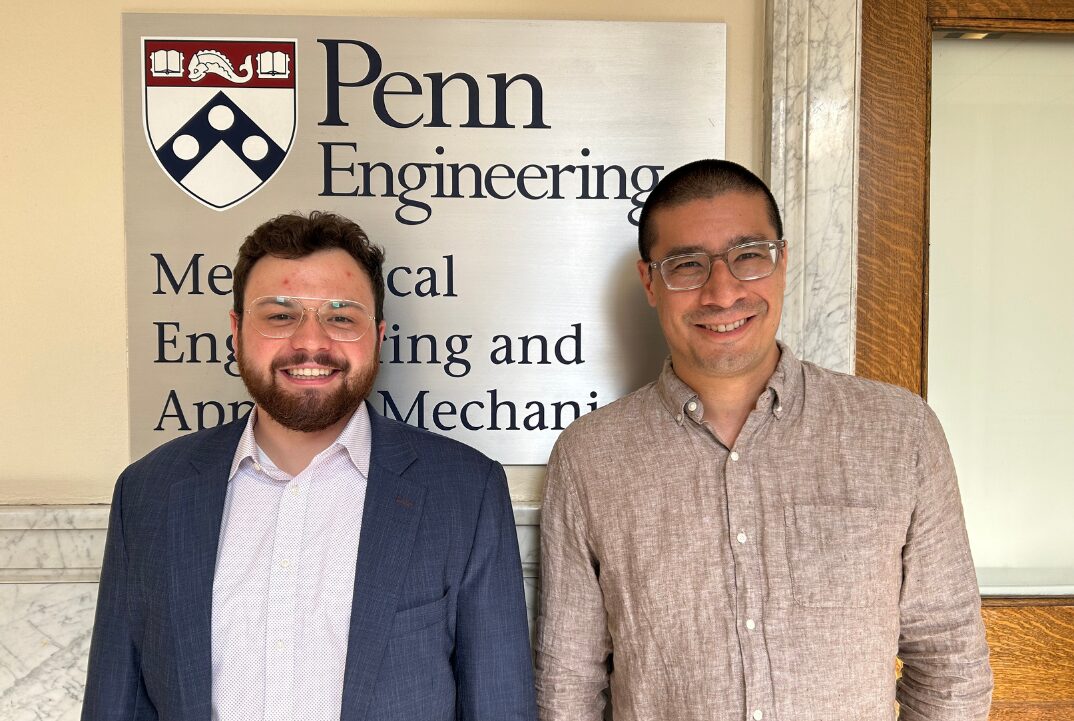
blog.me.upenn.edu/brian-acosta-defends-dissertation-on-real-time-locomotion-control-for-bipedal-robots
Preview meta tags from the blog.me.upenn.edu website.
Linked Hostnames
12- 13 links toblog.me.upenn.edu
- 1 link tobrianacosta.me
- 1 link todair.seas.upenn.edu
- 1 link todirectory.seas.upenn.edu
- 1 link toevents.seas.upenn.edu
- 1 link totwitter.com
- 1 link towordpress.org
- 1 link towww.facebook.com
Thumbnail

Search Engine Appearance
Brian Acosta Defends Dissertation on Real-Time Locomotion Control for Bipedal Robots
Brian Acosta has successfully defended his doctoral dissertation, “Real-Time Perception and Mixed-Integer Footstep Control for Underactuated Bipedal Walking on Rough Terrain” under the guidance of Michael Posa, Assistant Professor in Mechanical Engineering and Applied Mechanics (MEAM). Acosta's research in the Dynamic, Autonomy and Intelligent Robotics (DAIR) Lab tackles the challenge of enabling bipedal robots to traverse complex, unpredictable environments. Traditional systems separate perception and control, limiting real-world adaptability. His work brings these two processes together using a model-predictive-control-style planner that accounts for both the robot's dynamics and real-time perception of terrain. By segmenting safe terrain using a novel, fast, and locally based algorithm, his approach enables the bipedal robot Cassie to walk across previously unseen, discontinuous terrain. The result is a robust, integrated system that advances the field of perceptive locomotion and sets the stage for real-world deployment in environments too hazardous for humans. Reflecting on his Ph.D. experience, Acosta describes it as deeply rewarding and intellectually freeing. “It really is as close as you can get to total freedom to spend your time learning about whatever you find interesting,” he said, particularly enjoying the deep dive into numerical optimization and control systems. Some of his most memorable moments came from testing new walking controllers—moments of success, and plenty of instructive failures. Along the way, he credits his advisor Michael Posa, the DAIR lab team, and the MEAM department staff for their critical support. “Peter, Jonathan, and the MEAM machine shop staff have been invaluable—especially during Cassie’s many repairs.” After graduation, Acosta will continue his work on bipedal locomotion as a robotics engineer at Figure AI.
Bing
Brian Acosta Defends Dissertation on Real-Time Locomotion Control for Bipedal Robots
Brian Acosta has successfully defended his doctoral dissertation, “Real-Time Perception and Mixed-Integer Footstep Control for Underactuated Bipedal Walking on Rough Terrain” under the guidance of Michael Posa, Assistant Professor in Mechanical Engineering and Applied Mechanics (MEAM). Acosta's research in the Dynamic, Autonomy and Intelligent Robotics (DAIR) Lab tackles the challenge of enabling bipedal robots to traverse complex, unpredictable environments. Traditional systems separate perception and control, limiting real-world adaptability. His work brings these two processes together using a model-predictive-control-style planner that accounts for both the robot's dynamics and real-time perception of terrain. By segmenting safe terrain using a novel, fast, and locally based algorithm, his approach enables the bipedal robot Cassie to walk across previously unseen, discontinuous terrain. The result is a robust, integrated system that advances the field of perceptive locomotion and sets the stage for real-world deployment in environments too hazardous for humans. Reflecting on his Ph.D. experience, Acosta describes it as deeply rewarding and intellectually freeing. “It really is as close as you can get to total freedom to spend your time learning about whatever you find interesting,” he said, particularly enjoying the deep dive into numerical optimization and control systems. Some of his most memorable moments came from testing new walking controllers—moments of success, and plenty of instructive failures. Along the way, he credits his advisor Michael Posa, the DAIR lab team, and the MEAM department staff for their critical support. “Peter, Jonathan, and the MEAM machine shop staff have been invaluable—especially during Cassie’s many repairs.” After graduation, Acosta will continue his work on bipedal locomotion as a robotics engineer at Figure AI.
DuckDuckGo
 https://blog.me.upenn.edu/brian-acosta-defends-dissertation-on-real-time-locomotion-control-for-bipedal-robots
https://blog.me.upenn.edu/brian-acosta-defends-dissertation-on-real-time-locomotion-control-for-bipedal-robotsBrian Acosta Defends Dissertation on Real-Time Locomotion Control for Bipedal Robots
Brian Acosta has successfully defended his doctoral dissertation, “Real-Time Perception and Mixed-Integer Footstep Control for Underactuated Bipedal Walking on Rough Terrain” under the guidance of Michael Posa, Assistant Professor in Mechanical Engineering and Applied Mechanics (MEAM). Acosta's research in the Dynamic, Autonomy and Intelligent Robotics (DAIR) Lab tackles the challenge of enabling bipedal robots to traverse complex, unpredictable environments. Traditional systems separate perception and control, limiting real-world adaptability. His work brings these two processes together using a model-predictive-control-style planner that accounts for both the robot's dynamics and real-time perception of terrain. By segmenting safe terrain using a novel, fast, and locally based algorithm, his approach enables the bipedal robot Cassie to walk across previously unseen, discontinuous terrain. The result is a robust, integrated system that advances the field of perceptive locomotion and sets the stage for real-world deployment in environments too hazardous for humans. Reflecting on his Ph.D. experience, Acosta describes it as deeply rewarding and intellectually freeing. “It really is as close as you can get to total freedom to spend your time learning about whatever you find interesting,” he said, particularly enjoying the deep dive into numerical optimization and control systems. Some of his most memorable moments came from testing new walking controllers—moments of success, and plenty of instructive failures. Along the way, he credits his advisor Michael Posa, the DAIR lab team, and the MEAM department staff for their critical support. “Peter, Jonathan, and the MEAM machine shop staff have been invaluable—especially during Cassie’s many repairs.” After graduation, Acosta will continue his work on bipedal locomotion as a robotics engineer at Figure AI.
General Meta Tags
10- titleBrian Acosta Defends Dissertation on Real-Time Locomotion Control for Bipedal Robots – MEAM Blog @ Penn Engineering
- charsetUTF-8
- viewportwidth=device-width, initial-scale=1
- robotsmax-image-preview:large
- generatorWordPress 6.8.2
Open Graph Meta Tags
10og:locale
en_US- og:site_nameMEAM Blog @ Penn Engineering
- og:titleBrian Acosta Defends Dissertation on Real-Time Locomotion Control for Bipedal Robots
- og:urlhttps://blog.me.upenn.edu/brian-acosta-defends-dissertation-on-real-time-locomotion-control-for-bipedal-robots/
- og:typearticle
Twitter Meta Tags
3- twitter:titleBrian Acosta Defends Dissertation on Real-Time Locomotion Control for Bipedal Robots
- twitter:imagehttps://blog.me.upenn.edu/wp-content/uploads/2025/05/Blog-Featured-Images-1.jpg
- twitter:cardsummary
Link Tags
24- EditURIhttps://blog.me.upenn.edu/xmlrpc.php?rsd
- alternatehttps://blog.me.upenn.edu/feed/
- alternatehttps://blog.me.upenn.edu/wp-json/wp/v2/posts/1137
- alternatehttps://blog.me.upenn.edu/wp-json/oembed/1.0/embed?url=https%3A%2F%2Fblog.me.upenn.edu%2Fbrian-acosta-defends-dissertation-on-real-time-locomotion-control-for-bipedal-robots%2F
- alternatehttps://blog.me.upenn.edu/wp-json/oembed/1.0/embed?url=https%3A%2F%2Fblog.me.upenn.edu%2Fbrian-acosta-defends-dissertation-on-real-time-locomotion-control-for-bipedal-robots%2F&format=xml
Links
24- https://blog.me.upenn.edu
- https://blog.me.upenn.edu/3d-graphene-structures
- https://blog.me.upenn.edu/author/sibleyc
- https://blog.me.upenn.edu/brian-acosta-defends-dissertation-on-real-time-locomotion-control-for-bipedal-robots
- https://blog.me.upenn.edu/category/faculty